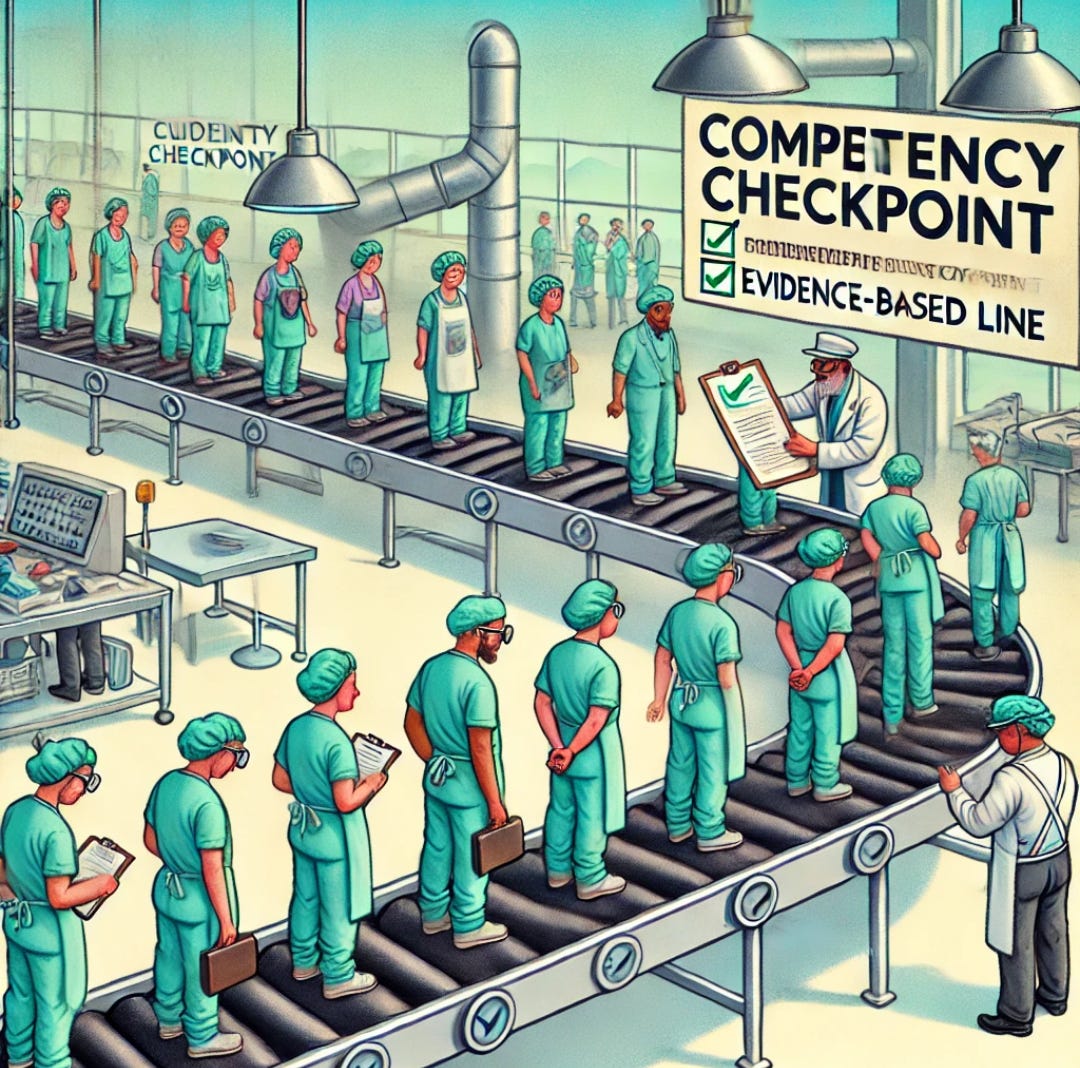Physio Manifesto I | Quality Control - Are you still good?
Why competency checks matter, and how other professions do them better.
This is a no-paywall blog post with insights I believe are valuable. If you find it useful, subscribe to my Substack for more in-depth content, exclusive case studies, and clinical insights.
Your support helps me continue sharing everything I’ve learned in the clinic with the world.
☕ Prefer a one-off thank you? Buy Me a Coffee.
This post is a guide only and should not be taken as medical advice. It does not replace assessment and recommendations from a registered and regulated healthcare professional.
Contents
🔹 Prologue - Cleaning the House, Selling the House, and Staying in It (🔗link)
You are here👇
🔹 Chapter I – Quality Control | “Are You Still Good?” Why competency checks matter, and how other professions do them better. (🔗link)
🔹 Chapter II – Credentialing | “The Title that Doesn’t Entitle” How we can make APA Titling meaningful and externally recognised. (🔗link)
🔹Chapter III – Branding | “What’s the Flavour?” Fixing the physio lucky-dip: labelling our services so patients know what they’re getting. (🔗link)
🔹 Chapter IV – Public Recognition | “The Public and the Public Purse” Why the public still doesn’t get us, and what happens when they do. (🔗link)
🔹 Chapter V – Retention | “Keep the Good Ones” How recognition, pay, and purpose drive the longevity of experienced clinicians. (🔗link)
🔹 Epilogue - Diplomacy Failed. This Is My Fart in the Wind. (🔗link)
There’s something reassuring about airline pilots. You don’t really worry if they’re competent. You assume they’ve done the drills. You assume someone checks. Because someone does.
In aviation, there’s structure. If you’re flying the public around at 900 km/h, the bar is high — and it’s maintained.
Emergency Procedures (every 12 months):
A full-day practical assessment covering fire, decompression, medical events, ditching, evacuation slides, raft drills, and all the “what-if” chaos you hope never happens mid-air.Flight Simulators (every 4 months):
Simulated flights under controlled pressure — engine failures, crosswind landings, systems faults — with real-time decisions under scrutiny.Route Checks (every 2 years):
A qualified assessor sits in the jump seat on a real, routine flight to evaluate standard operating procedures, decision-making, communication, and crew performance in live conditions.
Now imagine if pilots never had to prove their competency again after getting licensed. Just show up once a year with a self-declared logbook that says you “watched a video” or “talked to a mate about landing gear.”
No one flies that airline.
But in physiotherapy? That’s us.
We Have a Code. We Don’t Have Checks.
The Physiotherapy Board of Australia has a Shared Code of Conduct. It says all the right things:
“Don’t over-service.”
“Use evidence-based care.”
“Stay within your scope.”
But it’s a wishlist, not a system.
We still see:
Physiotherapists seeing two-patients at the same time.
Clinics enforcing “2x/week for all insurance patients” policies — regardless of complexity or need.
Providers doing the same hands-on routine for every patient, every week.
Who’s watching this? Who’s checking?
Answer: no one — unless a complaint is lodged.
And even then, it’s often too little, too late.
According to Ahpra’s 2020/21 Annual Report, over a quarter of complaints against physiotherapists related to clinical care — the second most common issue overall. Some of these likely involved dry needling. And in one case, a compensation claim against a massage therapist topped $1 million and dragged on for three years. Poor clinical care isn’t just risky — it’s expensive.
The Evidence Is Clear (and Embarrassing)
A 2019 BMJ Open systematic review by Zadro et al. found that only 54% of physiotherapists provided recommended treatments when managing musculoskeletal conditions. The rest delivered either low-value, not-recommended, or “meh, we don’t know” interventions.
That’s not just a clinical problem — it’s a branding crisis. Imagine if your GP was only right 50% of the time.
We keep saying we’re evidence-based. But if half the profession isn’t, we’re not a profession — we’re a coin flip.
What Should Quality Control Actually Look Like?
Here’s the model — stolen shamelessly from aviation, and long overdue in allied health:
✅ Route Check (every 2 years)
Someone from the Australian Physio Board reviews our clinical practice.
Video recording of a consult externally submitted. Other healthcare professionals already record some consults for training and registration purposes - eg: Provisional Psychologists.
Alternatively, shadowed clinical observation in the clinical rooms.
Focused on clinical reasoning, communication, documentation.
✅ Emergency Procedures (yearly)
Online case-based scenarios covering red flag triage:
Cauda equina
Spinal infections
Cancer masquerading as MSK pain
Inflammatory/rheumatological patterns
✅ Flight Simulators (quarterly)
Structured case management scenarios - easily provisioned and accessed via online learning platforms:
Rotator cuff / subacromial referred pain
Knee OA
Tendinopathy
Patellofemoral pain
Lateral elbow pain
Traumatic shoulder/knee injuries
Open book testing. Allow 1 month re-sit for those deemed ‘not yet competent’.
These aren’t trick questions. This is base-level pattern recognition.
If we can’t demonstrate competence in these, how are we a trusted profession?
CPD Isn’t the Problem — It’s the Lack of Structure
I do easily 100-200hrs of CPD a year — podcasts, papers, case discussions, writing, reviewing. Not because I’m told to. Because it matters.
But the current system?
20 hours.
Self-recorded.
No audit.
No quality check.
You could press play on a 1998 pseudoscience webinar and then go play Clash of Clans. Tick. CPD done.
There is no assessment. There is no demonstration of learning.
There is no proving you are still good.
Getting Investigative
I Asked AHPRA if They Check Our Work. Here’s What I Found.
Step 1: Just an Email
I asked AHPRA how often they actually audit physiotherapists to ensure we’re meeting professional standards.
Their response?
“Our primary role is to protect the public and set standards and policies that all registered health practitioners must meet. Unfortunately, myself or Ahpra are not able to advise on statistic matters.”
Which I found… let’s say, amusing. Because if the goal is to protect the public, wouldn’t knowing whether those standards are enforced be kind of essential?
Step 2: Formal FOI Request
So I submitted a formal Freedom of Information (FOI) request to AHPRA and the Physiotherapy Board of Australia.
A month later, I received a bundle of documents outlining how audits were conducted—but only for the 2021 and 2022 audit cycles.
🔍 What I Found
Yes—audits do exist. But they were strictly focused on administrative compliance, not clinical quality. Those audits only checked:
✅ Criminal history
✅ Professional indemnity insurance (PII)
✅ Recency of practice (RoP)
They didn’t assess:
❌ Clinical reasoning
❌ Diagnosis
❌ Treatment quality
❌ Outcome measures
And the FOI documents included nothing beyond that two-year window. So despite an email and a formal FOI request, I still don’t know how often—if ever—physiotherapists are being checked in recent years for the things that actually affect patient care.
The CPD Illusion – 2021 & 2022
The FOI documents also confirmed that CPD wasn’t audited during this period. The Physiotherapy Board had announced it wouldn’t take action against practitioners who didn’t meet CPD requirements due to the COVID-19 pandemic.
So while CPD normally requires 20 hours, a learning plan, and a reflective portfolio, none of it was checked—at least officially—in these audit cycles.
Imagine your airline pilot saying, ‘Nah, didn’t do any flying hours this year. But it’s fine—I renewed my licence online.’
Welcome to CPD in a pandemic.
So I asked ‘The People’
After sharing a shout-out on LinkedIn, I heard from several physios who were asked to submit their CPD logs in recent years. So the audits are happening—but there's:
No public data on how often,
No clear communication about who's targeted, and
No transparent system for monitoring clinical competence.
It’s all a bit… foggy.
This Isn’t Just About Standards — It’s About Public Safety
We are first contact practitioners.
We triage red flags.
We diagnose undifferentiated pain.
We sit one layer above the emergency room in some cases.
And yet — we’re never retested.
No clinical rechecks. No external reviews. No competency frameworks.
If we’re going to call ourselves primary contact healthcare providers, we need to start acting like it — and be held to the same standards.
Cleaning the House Starts Here
This is the first job.
Before we talk titles, branding, Medicare rebates or private insurance—we must have a quality control system that ensures physiotherapists are:
Competent
Up to date
Safe
Measurably effective
Without it, nothing else matters.
Let’s make sure we’re not just “registered.”
Let’s make sure we’re still good.
The entire Chapter III on Branding probably won’t even have to exist if we get Standards and Competency Checking right. Right now it’s just a contingency.
I get it… it’ll be hard. Being assessed is out of the comfort zone for most. But it’s very easy to sit back and relax, and never evolve as a evidence-based, high quality Clinician. I don’t know about you, I didn’t get into Healthcare to 'take it easy’.
Coming next Chapter II – Credentialing | “The Title that Doesn’t Entitle” How we can make APA Titling meaningful and externally recognised. (🔗link)
Did this challenge your thinking or add value to your patient care? If so, even a small contribution helps me keep content like this going.
If this post helped you rethink an approach, refine a diagnosis, or improve patient outcomes, consider supporting my work.
☕ Buy Me a Coffee to say thanks, or become a paid subscriber—healthcare providers who subscribe can share cases with me or ask clinical questions anytime.
Tailor your Nick Ilic | Physio Clinician subscription:
You can customise which topics you receive updates for by selecting 'Manage Subscription' in your Substack options (in your browser), or by clicking 'unsubscribe' at the bottom of any email—don’t worry, it won’t unsubscribe you immediately! You'll then be able to choose your preferred sections:
✅ Patient Playbook
✅ Clinician’s Corner
✅ Research Reviews
✅ Clinician’s Compass
Choose what suits you best—I promise I won’t take it personally!













